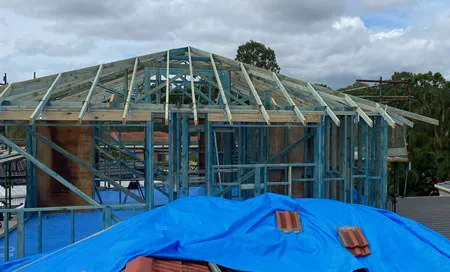🔥 Second storey home additions can increase their value by fifty percent*. This ranks among the most valuable home improvements you can make.
Your current space might feel cramped, or you may want to tap into your property’s full potential. Second storey home additions provide an innovative solution that doubles your living space without expanding your home’s footprint. Most projects take 20-24 weeks to complete.
Our 30+ years as the Gold Coast’s second-story specialists have shown that costs range from $2,500 to $5,500 per square meter. The final price depends on your specific needs and design choices. The investment pays off through increased property value and extra living space.
Want to transform your home with a second storey addition? Let’s explore what you need to know about planning, designing and executing this game-changing home improvement project.
Why Second Storey Additions Make Sense Today
Multigenerational families now prefer second storey home additions that solve their changing needs. This smart building choice brings huge benefits, especially when you have families who want more living space but love their current location.
Growing Family Needs
Second storey additions create perfect spaces that give growing households the room they need without losing privacy. Families can double their living space and create separate areas for different activities and family members. In addition, they help with built-in childcare support and let different generations share their parenting wisdom.
The money side makes sense for multigenerational households. Family members can split the original investment, which makes it an affordable housing option. They also skip the big costs of moving houses, like real estate fees and moving expenses.
Land Space Limitations
Urban areas like the Gold Coast and surrounding suburbs of the Northern Rivers keep growing, and buildable land becomes scarce. Second storey additions provide a clever answer to space problems. Your valuable outdoor areas stay intact, which matters in city settings where garden space is hard to find.
Here’s what building upward gives you:
- Your gardens and outdoor entertainment areas stay untouched
- Swimming pools and landscaping remain the same
- You get better views and more privacy
- The house footprint can stay, while the living space doubles
Property Value Benefits
Second storey additions bring solid financial rewards. A well-done second storey can increase your property’s value by approximately fifty percent. This gives you the best return among all home additions. Houses that double in size through upward expansion tend to gain value faster in 5-year-old neighborhoods than in newer areas.
Your property value goes up because:
- You get extra bedrooms and living spaces
- The architectural appeal improves with clever design
- The street presence looks better
- Outdoor space stays valuable
The market loves second storey additions near key amenities. Properties with quality upper levels attract families who want bigger homes near medical centers, schools, shops, and public transport.
These additions do more than help your family right now. The extra space works for many needs, from home offices to entertainment zones, which future buyers love. This flexibility, plus keeping your yard space and getting possible views, makes upward expansion a smart choice for homeowners.
Planning Your Second Storey Addition
The path to a successful second storey addition starts with careful planning. A well-laid-out approach will give you a project that stays on track and meets your expectations.
Setting Clear Goals
Your second storey project needs specific requirements for your new space. Consider your current needs and future plans, such as extra bedrooms, bathrooms, or dedicated activity areas. Experienced designers will help you review essential factors like:
- How to best use natural light and optimize views
- Ways to control temperature through cross-ventilation
- Clever window placement for privacy
- Adding energy-efficient features
Budget Planning
Second storey additions typically cost between AUD 2,752.18 to AUD 22,934.85 per square meter. All the same, several factors affect the final cost:
- Design complexity and specifications
- Types of rooms (bathrooms and kitchens cost more)
- Quality of materials and finishes
- Access to your site
Your financial plan should include 20-25% as contingency funds. This buffer helps handle unexpected costs during construction. Second storey additions often provide affordable solutions compared to ground-floor extensions because they don’t need foundation work.
Timeline Creation

- Original Assessment (2-3 weeks)
-
- Review of structural feasibility
- Check of foundation load-bearing capacity
- Review of existing home condition
- Design and Approval Phase (6-8 weeks)
-
- Architectural planning
- Council submission
- Building permit acquisition
- Construction Phase (12-16 weeks)
-
- Roof removal and protection
- Structural framework installation
- Interior finishing
You might need temporary living arrangements during construction, as utilities could sometimes be disconnected. Some homeowners leave the property entirely, while others can stay in parts of their existing space.
Structural engineers should first review your home’s foundation capacity. This review shapes the feasibility of your planned addition and affects material choices. Experienced architects can then create designs that merge naturally with your existing structure.
Note that you should update your insurance coverage before construction begins. Standard policies might not protect original structures during renovation work. You need complete coverage for both existing and new construction elements.
The best results come from builders who specialise in second storey additions. Look for experts who can:
- Protect against the weather during roof removal
- Handle utility changes
- Control noise and dust effectively
- Keep the site safe throughout construction
Key Design Decisions for Your Addition
Your second-story addition needs careful planning to blend perfectly with your existing home. Every choice you make – from layout to where you put the windows – shapes your project’s outcome.
 Choosing the Right Layout
Choosing the Right Layout
A good layout begins with deciding which rooms go upstairs. Most designs work best with these setups:
- Kids’ zone with bedrooms, bathroom, and activity area
- Master retreat with ensuite, walk-in-robe, and study
- Complete bedroom level with extra living space
Smart layouts include rooms that adapt to changing needs. Open floor plans are a popular choice because they offer flexibility and space.
Staircase Placement Options
Your staircase does more than connect floors—it becomes part of your home’s design. A good staircase brings in natural light and offers easy access without taking up too much ground-floor space.
Here’s what matters when placing your stairs:
- How people move through the space
- Getting the most natural light
- Saving ground floor space
- Moving furniture easily
Builders often add features around staircases to create useful spaces. The area under stairs works great for storage drawers, wine fridges, or small powder rooms.
Matching Old and New Designs
Your addition should look like it was always there. Making old and new parts work together takes careful planning.
You can create a unified look by:
- Using matching window styles and crown moldings
- Picking the same roofing and siding materials
- Keeping trim details and finishes consistent
- Adding modern features without spoiling the look
Sometimes, exact matches aren’t possible. Using more straightforward trim or different but complementary materials can make your addition look like an original part of the house.
Window Placement Strategy
Windows affect both looks and function. In second-story additions, windows are vital for:
- Bringing in natural light
- Getting fresh air
- Keeping privacy
- Making the most of views
Each window style serves a purpose. Awning windows work best in bedrooms and bathrooms where privacy and air control are desired. Double-hung windows offer classic looks and versatility.
High-set windows help with privacy and heat control for west-facing rooms or those overlooking neighbors. The Building Code of Australia requires safety features, including restrictor devices or barriers, for windows with a drop of 2 meters or more.
Think about these factors for window placement:
- Which way rooms face and what they’re used for
- How much privacy do you need
- Air flow patterns
- Views and light
Upper-level windows face fewer obstacles, making them perfect for daylight and views. Large windows in living spaces and bedrooms bring in lots of natural light and help with orientation.
Understanding Construction Requirements
Building a second story requires a full structural evaluation to ensure your home can handle the extra weight. Getting a professional assessment is the lifeblood of any successful vertical expansion project.
 Foundation Assessment
Foundation Assessment
A structural engineer will check if your foundation can support a second story’s weight. This evaluation looks at several key factors:
- Load-bearing capacity of existing foundations
- Current structural integrity
- Soil conditions and stability
- Potential need for reinforcement
Homes built on concrete slabs usually work well for second story home additions. However, properties with bearers, joists, and brick piers might need extra structural changes.
Here’s what happens during foundation assessment:
- Detailed analysis of current foundation strength
- Evaluation of existing structural elements
- Assessment of load distribution patterns
- Identification of potential reinforcement needs
Structural Support Needs
Your home’s existing structure needs careful examination beyond just the foundation. A licensed engineer will calculate structural actions and pick the correct elements to keep structural movement minimal. This analysis will clearly show how well the lower level can support your new addition.
The structural support check will cover:
- Wall strength assessment
- Beam placement strategy
- Load distribution analysis
- Support system requirements
Structural engineers focus on three main areas:
- Foundation integrity
- Roofing system capacity
- Load-bearing wall assessment
Your first floor will likely need changes since the existing bottom-story walls can’t support an upper level alone. The structural reinforcement might include:
- Foundation strengthening
- Wall reinforcement
- Additional support beams
- Modified load-bearing elements
The structural assessment helps determine your second storey extensions project size limits and material choices. Since these additions change your home’s basic structure, you’ll also need council approval.
Older homes might need specific reinforcement strategies. If the existing structure isn’t suitable for going up, you might want to consider ground-floor extensions instead.
A complete structural evaluation protects your investment and your family’s safety. Professional engineers ensure every part of the structural system meets or exceeds building code requirements. This all-encompassing approach and proper reinforcement strategies create a solid base for your second story addition project.
Managing the Building Process
Your second storey addition project starts with selecting experienced professionals. A well-managed construction process will give smooth execution and superior results.
Choosing the Right Builder
Professional builders with specific second storey addition expertise bring several advantages:
- Experience with local council regulations and building codes
- Understanding of structural requirements
- Knowledge of weather protection during construction
- Proven track record of successful projects
These factors matter when you evaluate potential builders:
- Verify their experience with similar projects
- Check their licensing and insurance coverage
- Review past client testimonials
- Assess their communication style and responsiveness
Living Arrangements During Construction
Second-storey additions take 20-24 weeks to complete. During this time, you have two main options: stay in your home or find temporary accommodation.
Builders help families who choose to stay with specific measures:
- Installation of temporary protective sheets to contain dust
- Creation of construction-free zones
- Strategic scheduling of utility disconnections
- Implementation of safety barriers
Smart builders combine structural designs that enable wall demolition after completing the upper level. Families can move upstairs first, which makes downstairs alterations more manageable.
Project Timeline Phases
Your second storey addition typically follows this timeline:
Weeks 1-6:
- Demolition and structural preparation
- Installation of floor joists
- Construction of exterior walls
- Roof truss installation
Weeks 6-10:
- Completion of rough-ins
- AC, plumbing, and electrical work
- Building Certifier inspections for compliance
Weeks 10-16:
- Insulation installation
- Plasterboard installation and finishing
- External cladding work
Weeks 16-22:
- Interior finishing
- Flooring installation
- Cabinet and countertop fitting
- Final inspections
🏗️ Quality Control Steps
High standards throughout construction need systematic quality control measures. Professional builders use these key checks:
Foundation and Structural Connections:
- Regular engineering inspections
- Verification of support system integrity
- Assessment of load-bearing elements
Waterproofing and Insulation:
- Moisture barrier installation checks
- Insulation material verification
- Ventilation system testing
Documentation and Compliance:
- Council approval verification
- Engineering certification review
- Regular inspection reports
- Building code compliance checks
Final Stage Verification:
- System functionality testing
- Defect identification and resolution
- Full completion inspection
- Council certification confirmation
Weekly progress meetings with your builder help ensure project success. You can review completed work, confirm decisions, and address concerns. In addition, keep detailed records of changes, decisions, and important conversations throughout the construction process.
Standard policies might not cover damage during construction. You should look into specific construction insurance that protects existing structures and new work throughout the building process.
Conclusion
Craig Preston, Master Builder on the Gold Coast
Risen Developments delivers stress-free second storey additions that are among today’s most valuable home improvements. Our 30 years as the Gold Coast’s second-story specialists help families expand their homes while securing strong investment returns.
Quality second storey additions start with the right builder. Our no-nonsense building process combines careful planning, structural knowledge, and professional execution. Family needs shape every project decision, ensuring results that meet our highest standards.
Second storey additions give you more than just extra space. Your property value grows by 50% while you keep your preferred location and outdoor areas. Our proven approach guarantees structural integrity and lasting quality throughout construction.
The next step is to contact us about your second storey plans. Let our expertise guide you toward your expanded dream home.
We’ll turn your vision of a perfectly executed second storey addition into reality.
Our master builder, Craig, will chat with you at 0404 736 688. Feel free to email us online to ensure personalised advice that caters to your unique needs and aspirations. With the proper support, adding a second level to your home can be an enriching experience that breathes new life into your abode, making it an endeavour worth considering.When looking for any home addition on the Gold Coast or curious about the council’s requirements? Please click to Review Gold Coast council building applications.
# All photos and illustration artwork(s) are trademarked and intellectual property of Risen Development.
* Disclaimer: – * All costs displayed are for reference purposes only. It would be best to get a firm quotation on any size project.
🏡 Frequently Asked Questions
How much does a second storey addition typically cost?
The cost of a second storey addition can vary widely, typically ranging from $2,500 to $5,500 per square meter. Factors influencing the price include project complexity, design specifications, room types, material quality, and site access considerations.
How long does it take to complete a second storey addition?
On average, a second storey addition project takes about 20-24 weeks to complete. This timeline includes initial assessment, design and approval phases, and the actual construction process. However, the duration can vary depending on the project’s complexity and specific requirements.
Do I need to move out while constructing a second storey addition?
While staying in your home during construction is possible, many homeowners choose to find temporary accommodation. If you decide to stay, builders implement measures like dust containment, safety barriers, and strategic scheduling of utility work to minimize disruption.
Will a second storey addition increase my property's value?
A well-executed second-storey addition can significantly increase your property’s value. On average, it can boost your home’s value by approximately fifty percent, representing one of the highest returns on investment among home improvement projects.
What structural considerations are important for a second storey addition?
Key structural considerations include foundation assessment, evaluation of existing structural elements, and potential reinforcement needs. A thorough structural evaluation by professional engineers is crucial to ensure your home can support the additional weight and meet building code requirements.
🙂↕️Looking for related topics of Advice we’ve covered?
Second Storey Addition Cost Guide: What Builders Won’t Tell You [2025 Prices]
🔥Second Story Addition Cost Guide and Why Some Builders May Not Tell You the Real Prices....
Smart Parents’ Blueprint: Renovating a House Without Losing Your Sanity
One thing is how not to lose your sanity while renovating a house; add kids, and it's a recipe...
A Stepped Guide to 2nd Floor Additions to a House
🔥 If you're considering adding a second floor to your house, read on to see how our...


 Choosing the Right Layout
Choosing the Right Layout Foundation Assessment
Foundation Assessment







